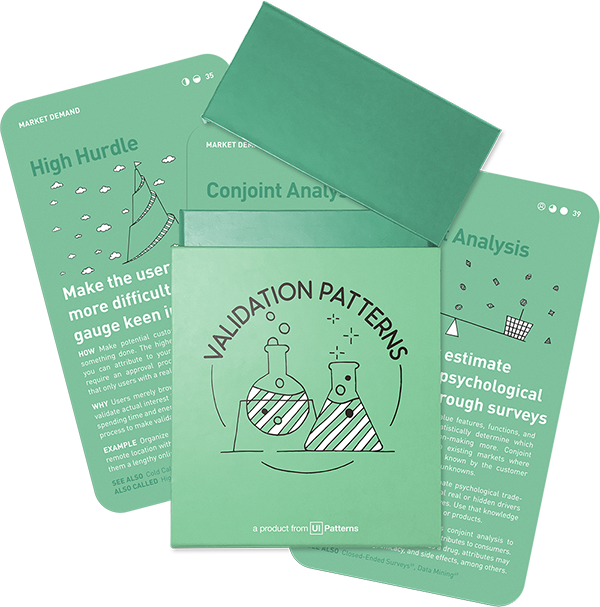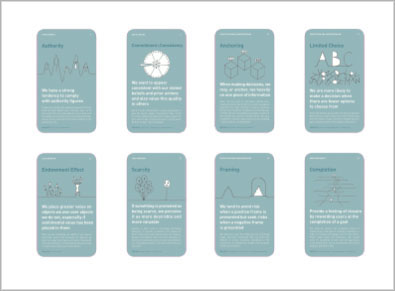Idea Validation: Market demand, Willingness to pay
Letter of Intent
Ask prospects to sign a non-binding contract to pay

How: Ask customers to sign a non-binding document outlining what they'll offer for your value proposition. Ideal prospects should have experienced the identified problems and currently use workarounds.
Why: This quick and direct method excels in assessing key partners and potential B2B customers. A signed letter of intent, though not legally binding, provides stronger evidence of partnership interest than verbal commitments.
At early stages of product development, the line between genuine interest and polite optimism can be dangerously thin. This is especially true in B2B contexts, where customers may verbally endorse your idea while never intending to buy it. The Letter of Intent (LOI) experiment was designed to bridge that gap by providing evidence of real interest—often before a product exists. It’s a structured way to validate demand, gauge feasibility, and align early stakeholders around a new solution.
While LOIs are often associated with formal business deals, in a lean validation context, they are non-binding documents in which a potential customer or partner expresses intent to engage with your offering once certain conditions are met. Used thoughtfully, they are a powerful tool for early discovery, helping you navigate the ambiguity of initial customer conversations with more confidence and clarity.
Why use a Letter of Intent?
The strength of the LOI lies in its ability to shift conversations from praise to proof. Early-stage teams often fall into the trap of mistaking encouraging words for real signals of demand. As Rob Fitzpatrick explains in The Mom Test, compliments aren’t commitments—and what people say in polite conversation rarely matches what they’ll do in real life. The LOI experiment helps you cut through that noise.
Securing a signed LOI represents a deeper level of customer engagement. It requires that the customer not only understand your proposed solution, but that they can see themselves actively benefiting from it. This goes beyond liking an idea—it’s about being willing to back it with their name, time, or future business.
In B2B contexts especially, LOIs serve multiple validation purposes. They can test desirability (is this something the customer actually wants?), viability (is the business model sound enough to generate future revenue?), and even feasibility (are partners or suppliers willing to support this?). According to David Bland, an LOI can also help close the “say-do” gap, providing a measurable behavioral signal that separates curiosity from intent.
LOIs also clarify your offer. Creating a well-defined LOI requires you to express your value proposition, delivery timeline, pricing assumptions, and service boundaries. In the process, you gain a more refined view of your own business model.
Testing pricing structures
Letters of Intent (LOIs) confirm customer readiness to purchase at specific prices, providing evidence of willingness to pay. They enable demand and price sensitivity assessment without committing resources to production or service at a set price. Analyzing segments willing to commit to higher prices refines pricing strategies and targets. Multiple LOIs at varying prices offer negotiation leverage and facilitate pricing adjustments based on actual customer commitments.
When Letters of Intent are a good fit for testing
The Letter of Intent experiment is best used when:
- You are still early in product development and need to validate demand.
- You are targeting business customers who are used to formal buying processes.
- You need concrete evidence for stakeholders or investors.
- Your solution is defined enough to articulate clearly in writing.
It’s less effective in B2C contexts, where consumers may be unwilling or unaccustomed to signing formal documents. It also shouldn’t be used prematurely. Asking for a commitment before the customer understands the problem or trusts the team risks generating false negatives—or worse, false positives that seem promising but have no real weight.
Crafting a meaningful LOI
An LOI should be short, clear, and contextual. It should specify what the product is, what problem it solves, what it might cost, and what the customer is agreeing to. Keep in mind: the goal isn’t to close a deal, but to validate intent. Focus on clarity over legal precision.
To make it meaningful, tie it to the customer’s current context. Has this problem caused them friction before? Have they already tried (and failed) to solve it? If the LOI is tied to an active, costly problem, it carries more weight. If not, it’s closer to a compliment than a commitment.
The strongest LOIs are the ones that involve some form of risk, effort, or reputational commitment from the signer. For example, an LOI that includes language about purchasing upon a condition (e.g., delivery date or feature set) is stronger than a vague expression of future interest. Likewise, an LOI from someone with real buying power carries more weight than one from someone with no decision-making authority.
Consider a stepwise commitment model
LOIs are part of a broader progression of customer validation. They can be seen as the midpoint in a four-step commitment ladder:
- Say: Verbal affirmation or general interest.
- LOI: Non-binding but written indication of intent.
- Contract: A binding agreement to purchase or collaborate.
- Payment: Tangible financial commitment or pilot investment.
This progression helps teams measure the strength of customer interest and avoid being misled by empty enthusiasm. If a potential customer is unwilling to sign an LOI, it may indicate that they’re not yet ready to advance in the relationship.
Investor leverage and strategic signaling
LOIs are also valuable for startups engaging with investors. An LOI from a reputable company shows that someone outside the team believes in the solution enough to sign their name to it. This can help reduce perceived risk and signal traction during funding conversations. Some founders include LOIs in their data rooms or pitch decks to demonstrate early demand, helping strengthen the case for a viable go-to-market strategy.
However, seasoned investors will view LOIs as a starting point. They are directional, not definitive. More convincing signals might include pilots, paid trials, or committed contracts—but an LOI is often a powerful first proof.
Letters of recommendation as an alternative
When it’s too early for a customer to commit to purchasing or signing a formal LOI, you might ask for a Letter of Recommendation or Endorsement instead. These letters—especially from senior stakeholders or domain experts—can serve as signals of credibility and can validate that your team or solution is worth watching.
While they don’t represent a promise to buy, they can still help you open doors with new customers, gain access to decision-makers, or establish trust with strategic partners.
Pairing LOIs with other research methods
The LOI experiment works best when paired with other lightweight experiments. For instance:
- Start with a Discovery Interview to understand pain points.
- Introduce a Landing Page or Concept Video to illustrate the offer.
- Use the LOI to formalize next steps and gather real-world validation.
- Follow up with a Concierge to further deepen the commitment.
LOIs can also complement formats like assumption mapping, pricing experiments, or partner interviews. By combining LOIs with methods that clarify both desirability and feasibility, you build a holistic picture of early-stage risk.
How to conduct the LOI experiment
Start by identifying customers who are already showing signs of engagement—perhaps those who’ve responded positively in interviews or pilot conversations. Frame the LOI as a mutual opportunity to formalize interest and align expectations. Provide supporting materials, such as sketches, a landing page, or a concept video.
Use the LOI as a conversation tool. Don’t just send it over email and hope it’s signed. Instead, walk through it with the customer, listening carefully to questions, hesitations, and pushback. As The Mom Test makes clear, these reactions are often more valuable than the document itself. If a customer is unwilling to sign, probe gently: what would need to change for this to be worth their while?
Track responses systematically. Whether signed or not, every conversation is a data point. A pattern of partial interest might signal a positioning issue, while consistent rejection might indicate a lack of problem urgency or product clarity.
Getting it right
The biggest mistake teams make with LOIs is overvaluing them. As Alice Bentinck noted, LOIs are easy to get and hard to interpret. They can provide a false sense of traction if taken at face value. Just because someone signs a document doesn’t mean they’ll actually buy your product. Treat LOIs as directional evidence—not confirmation.
Be especially wary of LOIs that come too easily. A non-specific LOI drafted to be universally agreeable can generate a pile of signatures that mean nothing. Similarly, pushing for an LOI in a high-pressure meeting might yield an insincere agreement made out of politeness or obligation. These are worse than having no LOI at all.
Measuring and interpreting results
The success of the LOI method is typically measured by the acceptance rate and the feedback received. A high acceptance rate indicates a strong interest in your product, while valuable feedback can help you refine your offering.
Interpreting these results should be done in the context of your overall product discovery process. Remember, the LOI is just one tool in your toolkit. It provides valuable insights, but it should be used in conjunction with other methods for a comprehensive understanding of your product’s potential.
Beyond the signature: what comes next
A signed LOI is not the end goal—it’s a doorway to further discovery. Use it as a stepping stone to:
- Schedule deeper discovery interviews.
- Test pricing models or payment terms.
- Launch a concierge or pilot offering.
- Involve the customer in co-design or roadmap shaping.
It can also support investor conversations. An LOI from a credible company signals market interest and opens the door for strategic discussions. However, sophisticated investors will want to see more: actual purchase orders, early revenue, or deeper customer relationships.
A Letter of Intent is not a shortcut to validation, but a tool for deepening it. When used carefully, it helps you separate wishful thinking from meaningful traction. It’s a conversation starter, a filter, and a commitment probe all in one.
But like every lean experiment, the value of the LOI comes not from the document itself, but from what you learn through the process of earning it. The best LOIs are earned through empathy, clarity, and mutual trust—not pitching. When done well, they help teams make smarter decisions with less waste and more confidence.
Popular tools
The tools below will help you with the Letter of Intent play.
-
DocuSign
A widely-used electronic signature platform that enables secure, legally compliant signing of LOIs. Helpful for streamlining B2B validation workflows with traceable agreement history.
-
HubSpot CRM
HubSpot's CRM includes deal tracking and contact management features that are useful for managing the outreach and follow-up around LOIs in sales-led or partnership-led validation experiments.
Real life Letter of Intent examples
Source: fastercapital.com
Source: fastercapital.com
Source: fastercapital.com
Source: fastercapital.com
Source: fastercapital.com
A collection of 60 product experiments that will validate your idea in a matter of days, not months. They are regularly used by product builders at companies like Google, Facebook, Dropbox, and Amazon.
Get your deck!Related plays
- Testing Business Ideas by David J. Bland & Alexander Osterwalder
- Case Study: Using an LOI to get customer feedback on a minimum viable product
- The Lean Startup Circle Wiki / Case Study One
- Letter of Intent by BMI Lab at BMI Lab
- The Letter of Intent Fallacy by Alice Bentinck at Medium / Entrepreneur First
- Secure a Letter of Intent: From Idea to Investment by FasterCapital Editorial Team at FasterCapital
- The Significance of the Letter of Intent

